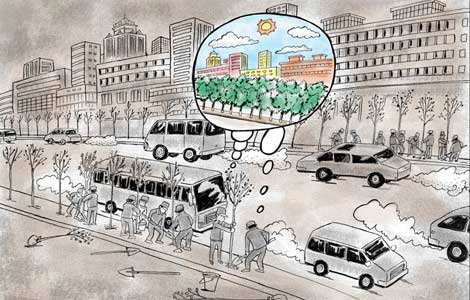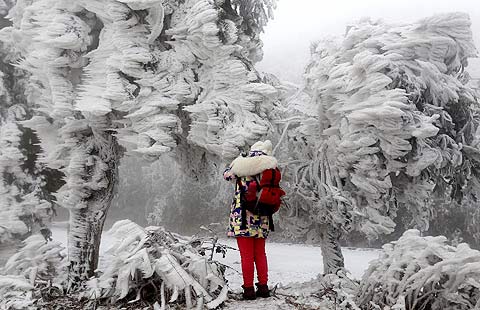China ponders energy strategy
Updated: 2014-02-13 13:45
(Xinhua)
|
|||||||||||
BEIJING - China's leading think tank has outlined a revamped energy strategy, highlighting new energy and calling for industrial transformation.
In an article entitled "Foreseeing and Analyzing China's Future Energy Development" published on the People's Daily, the flagship newspaper of the Chinese Communist Party, on Wednesday, Li Wei, head of the Development Research Center (DRC) of the State Council, said China must transform itself into a country of "security, greenery and efficiency" by 2030, or face with erratic supplies and unsurmountable environmental challenges.
Li's article is based on two years of research program led by the DRC and supported by over 70 experts from Royal Dutch Shell, Harvard University, and Tsinghua University, among others.
Energy supply & Environmental risks
Growth of China's energy demand will slow remarkably thanks to the cooling of the economy, but there will be higher dependency on foreign suppliers of oil and natural gas.
By 2030, as much as 75 percent of China's oil might be imported, and the dependency on overseas natural gas will also rise rapidly, bringing grave energy security concerns, Li warned.
A former senior official of the State Council, Li put energy security in a wider global context. By 2030, the world's energy supply will be much the same while demand will keep growing, partly due to industrialization of emerging economies.
There is also a fundamental shift in the world energy supply, with consumption gravitating east and production moving westward.
By 2030, China and India are expected to account for half of the world's oil consumption. The U.S., on the other hand, will likely be the center for world oil production by 2020, and aims to become the leader in deciding oil and gas prices.
China's energy supply risks might be exacerbated by complicated and volatile geopolitical situations, Li warned.
Even as the US has made breakthroughs in energy independence, it is unlikely to soften its grip on oil resources in the Middle East. Reduced dependence on foreign oil will make the US more hawkish in advancing its agenda in the region, making the world's energy market even more unpredictable.
"Rising risk for the energy transportation routes will pose new challenges which will be directly affected by geopolitical risks in the neighboring regions, the Middle East and Africa," he said.
Li also warned of the environmental challenge of increasing fossil fuel consumption. China's oil consumption will keep rising and reach 6 billion tonnes by 2020 and 8 billion tonnes by 2030 if it goes unchecked, putting pressure on the environment.
The road ahead
Li wants a "secure, green and efficient" system of energy production and consumption.
To secure supplies and avoid a sharp drop in energy self-sufficiency, China should explore new energy and natural gas, while stabilizing domestic oil production and moderately promoting oil made from coal, and the coal chemistry industry.
"Secure and effective" utilization of international resources requires China to set clear strategic goals to limit dependency on foreign oil and natural gas.
Li called for diversification of oil imports and less dependence on the Middle East as an oil supplier and the Strait of Malacca as a supply route.
Oil firms of oil producing countries would be encouraged to invest in China's middle and downstream oil business, while Chinese firms should invest abroad in the upper and middle stream business such as refineries.
To increase oil reserves, companies of all kinds should be encouraged to participate in the oil reserve system, and building an oil futures exchange should be accelerated, Li said.
China should also save more energy , he advised.
Total coal consumption should peak by 2020 and be capped below 3 billion tonnes. Oil consumption should be limited below 550 million tonnes by 2020 and capped at 650 million tonnes by 2030.
The article also set goals for energy efficiency. By 2030, the efficiency rate should reach "international advanced level," and energy consumption per capita GDP must be 30 percent lower than the 2020 level.
China should work to cap carbon dioxide emissions from energy consumption below 10 billion tons by 2030, or 7 tons per person, a similar level to Europe at the same time.
Li also highlighted the challenge of urbanization and called for green, low-carbon urbanization.
China's urbanization could reach 65 percent by 2030, another 300 million people in cities. Per capita urban energy consumption is normally about three times higher than rural, and an increase of one percentage point in urbanization rate implies increased energy consumption of 60 million tons of standard coal.
Urbanization should stick to a "compact city" principle, and the government should clearly define the boundaries of cities to avoid urban sprawl.
The researcher suggested market-oriented reforms as a solution. While promoting energy conservation, the government should let the market play a decisive role in the energy market.
Related Stories
China renews support for new-energy cars 2014-02-10 09:29
New-energy vehicles 'turning the corner' 2014-01-11 07:55
Solution to growth of new-energy firms blowing in the wind 2013-09-22 14:43
New-energy buses to hit the road in Shanghai 2013-02-20 17:44
Today's Top News
China's lunar rover comes back to life
No casualties reported in Xinjiang quake
Embassy in talks over arrest
Abe's view on history rapped
Prostitution crackdown expands in Guangdong
New visa policies a blessing for Chinese travelers
Chinese consume too much food from animals
Beijing low on list of green cities
Hot Topics
Lunar probe , China growth forecasts, Emission rules get tougher, China seen through 'colored lens', International board,
Editor's Picks

|

|

|

|

|

|





